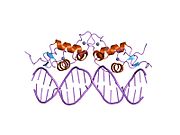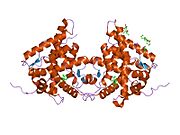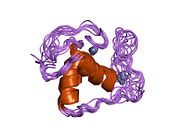Glucocorticoid receptor
| View/Edit Human | View/Edit Mouse |
The glucocorticoid receptor (GR or GCR) also known as NR3C1 (nuclear receptor subfamily 3, group C, member 1) is the receptor to which cortisol and other glucocorticoids bind.
The GR is
When glucocorticoids bind to GR, its primary mechanism of action is the regulation of gene transcription.[5][6] The unbound receptor resides in the cytosol of the cell. After the receptor is bound to glucocorticoid, the receptor-glucocorticoid complex can take either of two paths. The activated GR complex up-regulates the expression of anti-inflammatory proteins in the nucleus or represses the expression of pro-inflammatory proteins in the cytosol (by preventing the translocation of other transcription factors from the cytosol into the nucleus).
In humans, the GR protein is encoded by NR3C1
Structure
Like the other
and contains the following domains (labeled A - F):- A/B - N-terminal regulatory domain
- C - DNA-binding domain (DBD)
- D - hinge region
- E - ligand-binding domain (LBD)
- F - C-terminal domain
Ligand binding and response
In the absence of hormone, the glucocorticoid receptor (GR) resides in the cytosol complexed with a variety of proteins including
Transactivation
A direct mechanism of action involves
Transrepression
In the absence of activated GR, other transcription factors such as
Clinical significance
The GR is abnormal in
In
In preeclampsia (a hypertensive disorder commonly occurring in pregnant women), the level of a miRNA sequence possibly targeting this protein is elevated in the blood of the mother. Rather, the placenta elevates the level of exosomes containing this miRNA, which can result in inhibition of translation of molecule. Clinical significance of this information is not yet clarified.[21]
Agonists and antagonists
Dexamethasone and other corticosteroids are agonists, while mifepristone and ketoconazole are antagonists of the GR. Anabolic steroids also prevent cortisol from binding to the glucocorticoid receptor.
Interactions
Glucocorticoid receptor has been shown to
- BAG1,[22][23]
- CEBPB,[24]
- CREBBP,[25]
- DAP3,[26]
- DAXX,[27]
- HSP90AA1,[26][28][29][30][31][32][33]
- HNRPU,[34]
- MED1,[35][36]
- MED14,[36]
- Mineralocorticoid receptor,[37]
- NRIP1,[35][38][39]
- NCOR1,[40][41]
- NCOA1,[35][42]
- NCOA2,[35][43]
- NCOA3,[35][44]
- POU2F1,[45][46]
- RANBP9,[47]
- RELA,[47][48][49]
- SMAD3,[50][51]
- SMARCD1,[44]
- SMARCA4[44][52]
- STAT3,[53][54]
- STAT5B,[55]
- Thioredoxin,[56]
- TRIM28,[57] and
- YWHAH.[58]
See also
- Membrane glucocorticoid receptor
- Selective glucocorticoid receptor agonist(SEGRA)
References
- ^ a b c GRCh38: Ensembl release 89: ENSG00000113580 – Ensembl, May 2017
- ^ a b c GRCm38: Ensembl release 89: ENSMUSG00000024431 – Ensembl, May 2017
- ^ "Human PubMed Reference:". National Center for Biotechnology Information, U.S. National Library of Medicine.
- ^ "Mouse PubMed Reference:". National Center for Biotechnology Information, U.S. National Library of Medicine.
- S2CID 28626145. [Free full text]
- S2CID 5744727.
- PMID 2867473.
- PMID 2744768.
- S2CID 18333397.
- S2CID 25315991.
- PMID 16610357.
- PMID 16402112.
- PMID 15464020.
- PMID 8290595.
- PMID 20398732.
- PMID 9303314.
- PMID 11932321.
- PMID 17944926. [Free full text]
- PMID 19428959. [Free full text]
- PMID 26074844.
- PMID 28531338.
- PMID 9603979.
- PMID 11101523.
- PMID 9817600.
- PMID 9649342.
- ^ PMID 10903152.
- PMID 12595526.
- PMID 10066374.
- PMID 12093808.
- PMID 9334248.
- PMID 8898375.
- S2CID 20582144.
- PMID 8621522.
- PMID 9353307.
- ^ PMID 11266503.
- ^ PMID 10508170.
- PMID 11154266.
- PMID 12773562.
- PMID 10364267.
- PMID 12569182.
- PMID 12011091.
- PMID 12118039.
- S2CID 6955342.
- ^ PMID 12917342.
- PMID 10480874.
- PMID 9584182.
- ^ PMID 12361945.
- PMID 10995388.
- S2CID 28680611.
- S2CID 950035.
- PMID 10518526.
- PMID 10688647.
- PMID 14522952.
- PMID 9388192.
- S2CID 4356272.
- PMID 9915858.
- PMID 9742105.
- PMID 9079630.
Further reading
- Adcock IM, Ito K (June 2000). "Molecular mechanisms of corticosteroid actions". Monaldi Archives for Chest Disease = Archivio Monaldi per le Malattie del Torace. 55 (3): 256–266. PMID 10948677.
- Chikanza IC (June 2002). "Mechanisms of corticosteroid resistance in rheumatoid arthritis: a putative role for the corticosteroid receptor beta isoform". Annals of the New York Academy of Sciences. 966 (1): 39–48. S2CID 85100496.
- Neeck G, Kluter A, Dotzlaw H, Eggert M (June 2002). "Involvement of the glucocorticoid receptor in the pathogenesis of rheumatoid arthritis". Annals of the New York Academy of Sciences. 966 (1): 491–495. S2CID 5106644.
- Yudt MR, Cidlowski JA (August 2002). "The glucocorticoid receptor: coding a diversity of proteins and responses through a single gene". Molecular Endocrinology. 16 (8): 1719–1726. PMID 12145329.
- Torrego A, Pujols L, Picado C (September 2002). "[Response to glucocorticoid treatment in asthma. The role of alpha and beta isoforms of the glucocorticoid receptor]". Archivos de Bronconeumologia. 38 (9): 436–440. PMID 12237016.
- Bray PJ, Cotton RG (June 2003). "Variations of the human glucocorticoid receptor gene (NR3C1): pathological and in vitro mutations and polymorphisms". Human Mutation. 21 (6): 557–568. S2CID 26191891.
- Kino T, Pavlakis GN (April 2004). "Partner molecules of accessory protein Vpr of the human immunodeficiency virus type 1". DNA and Cell Biology. 23 (4): 193–205. PMID 15142377.
- Lu NZ, Cidlowski JA (June 2004). "The origin and functions of multiple human glucocorticoid receptor isoforms". Annals of the New York Academy of Sciences. 1024 (1): 102–123. S2CID 36368837.
- Kino T, Chrousos GP (June 2004). "Human immunodeficiency virus type-1 accessory protein Vpr: a causative agent of the AIDS-related insulin resistance/lipodystrophy syndrome?". Annals of the New York Academy of Sciences. 1024 (1): 153–167. S2CID 23655886.
- Andersen JL, Planelles V (January 2005). "The role of Vpr in HIV-1 pathogenesis". Current HIV Research. 3 (1): 43–51. PMID 15638722.
- Le Rouzic E, Benichou S (February 2005). "The Vpr protein from HIV-1: distinct roles along the viral life cycle". Retrovirology. 2 (1): 11. PMID 15725353.
- Muthumani K, Choo AY, Premkumar A, Hwang DS, Thieu KP, Desai BM, Weiner DB (August 2005). "Human immunodeficiency virus type 1 (HIV-1) Vpr-regulated cell death: insights into mechanism". Cell Death and Differentiation. 12 (Suppl 1): 962–970. PMID 15832179.
- Zhou J, Cidlowski JA (2005). "The human glucocorticoid receptor: one gene, multiple proteins and diverse responses". Steroids. 70 (5–7): 407–417. S2CID 24272404.
- Chrousos GP, Kino T (October 2005). "Intracellular glucocorticoid signaling: a formerly simple system turns stochastic". Science's STKE. 2005 (304): pe48. S2CID 23148406.
- Plotkin LL, Labutin AL, Lebedev LV, Khanukov LA, Zelikson OS (1975). "[Balloon probe for the removal of emboli and thrombi]". Meditsinskaya Tekhnika (3): 42–43. PMID 1152650.
- Subramaniam M, Colvard D, Keeting PE, Rasmussen K, Riggs BL, Spelsberg TC (December 1992). "Glucocorticoid regulation of alkaline phosphatase, osteocalcin, and proto-oncogenes in normal human osteoblast-like cells". Journal of Cellular Biochemistry. 50 (4): 411–424. S2CID 21381419.
- Scherrer LC, Pratt WB (March 1992). "Association of the transformed glucocorticoid receptor with a cytoskeletal protein complex". The Journal of Steroid Biochemistry and Molecular Biology. 41 (3–8): 719–721. S2CID 43672040.
- Cadepond F, Gasc JM, Delahaye F, Jibard N, Schweizer-Groyer G, Segard-Maurel I, et al. (July 1992). "Hormonal regulation of the nuclear localization signals of the human glucocorticosteroid receptor". Experimental Cell Research. 201 (1): 99–108. PMID 1612132.
- Hurley DM, Accili D, Stratakis CA, Karl M, Vamvakopoulos N, Rorer E, et al. (February 1991). "Point mutation causing a single amino acid substitution in the hormone binding domain of the glucocorticoid receptor in familial glucocorticoid resistance". The Journal of Clinical Investigation. 87 (2): 680–686. PMID 1704018.
- Encío IJ, Detera-Wadleigh SD (April 1991). "The genomic structure of the human glucocorticoid receptor". The Journal of Biological Chemistry. 266 (11): 7182–7188. PMID 1707881.
External links
- Human Protein Reference Database Archived 2006-03-01 at the Wayback Machine
- Glucocorticoid+receptors at the U.S. National Library of Medicine Medical Subject Headings (MeSH)
- FactorBook GR
- Overview of all the structural information available in the PDB for UniProt: P04150 (Glucocorticoid receptor) at the PDBe-KB.









